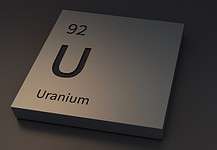COAL IN-SITU CONVERSION (ISC)
A Commercial Challenge Review
Introduction
In-situ conversion (ISC) of coal, also referred to as underground coal gasification (UCG) and in-situ coal gasification (ISG), is an industry process by which a coal seam is converted into a product gas, by combusting, pyrolysing and gasifying the coal in-situ in the presence of an oxidant, after the coal is ignited.
The product gas is typically referred to as synthesis gas or syngas and can be used as a feedstock for various applications, including fuels, fertilisers and chemicals production, including power co-generation or power only generation.
A coal seam having injection and production wells with a substantially horizontal wellbore linking the two is typically referred to as an in-situ coal conversion (ISC) gasifier or well pair (Fig. 1).
The well allowing the injection of oxidant is called an injection well. The well from which product syngas emerges, is called a production well. Both horizontal and vertical well regions can be used for injection and production of process streams.
The hot syngas produced in the coal seam by combustion, gasification, pyrolysis and other chemical reactions, flows downstream from the hot cavity and exits the coal seam through the production well.
The production well extends from the ground surface, where the production wellhead is located, all the way down into the coal seam, with the syngas flowing to the surface via the production well head. As coal is consumed or gasified, an ISC cavity within the coal seam develops and expands outwards and along the horizontal injection well liner over time.
The raw syngas, produced by the ISC process, typically contains syngas (a mixture of CO, CO2, H2, H2O and CH4) as well as other minor components (e.g. particulates, coal condensate, hydrocarbon vapours, inert gases, minor species of H2S, NH4, COS and many others), and the relative compositions will depend on various factors including the type of oxidant used for ISC (eg air, oxygen-enriched air mixtures or oxygen and steam mixtures, etc), water present within the coal seam and seeping from the surrounding strata towards the coal seam, coal quality and ISC operating parameters such as gasification temperature and pressure.
Here, a summary of the historical advancement of ISC technology will be provided. The commercial challenges of the ISC technology will be reviewed and potential solutions will be discussed.
ISC technology advancement review
The ISC technology has been gradually conceptualised and developed over the past 150 years.
- First Generation Technology:
It was mainly developed during the 1920s-1950s in the former Soviet Union. The technology makes use of vertical wells which are spaced not more than 50m apart, where the coal is ignited at one of the wells and oxidant injected in the other well at high pressure to establish a fractured link within the coal, where the combustion front burns back along the fractures towards the oxidant source, called reverse combustion linked wells. Once the link is established, the oxidant injection rate is increased until all the coal between the two wells are consumed. This technology is limited by the maximum 50m spacing between the vertical wells, subsidence occurring under/around the wells and by the economics only working for shallow coal seams.
- Second Generation Technology:
With the development of directional drilling technology, the ISC technology was significantly improved. During the 1960s-1970s, the USA had developed the Controlled Retraction Injection Point (CRIP) and Steeply Dipping Beds (SDB) technologies by having one of the wells directionally drilled and linked to the other well to establish the flow path for oxidant injection and syngas extraction to surface.
- Third Generation Technology:
Companies such as Linc Energy and Carbon Energy, in Australia, successfully developed the third generation ISC technology, based on the technology from the previous generations developed up to the 1990’s. In addition, the coiled tubing unit for enriched oxidant and coolant delivery is implemented at the Linc Energy Chinchilla site. The high-quality syngas was used as feedstock for power generation and producing synthetic fuels.
- The Fourth-Generation Technology:
Zhongwei Energy took the lessons learned from most of the field demonstration trials and developed the 4th generation ISC technology. The advances include, but are not limited to:
- A commercial scale concentric coiled tubing oxygen injection system to execute the CRIP method with 99.5% pure oxygen injection
- Downhole oxygen tools with real-time process KPIs feedback and active coolant control functions
- Easily deployable ignition tools and ignition tool delivery systems
- Thermal production wells and wellheads with a sub-surface gas quench system
- Multiple channels injection well and production well system
- Downhole ISC process monitoring and safety system
- Modular and movable ISC surface equipment
- Site ground water monitoring system

ISC commercial challenge
The ISC technology is close to a pivotal point of commercialisation after more than a century of research and development, especially with the advancements from lessons learned from decades of pilot plants. However, there are some challenges, which could significantly affect the success of ISC commercial projects and requires more attention during the ISC exploration, design and operational phases.
ISC process control
In the previous pilot plant operation, multiple “cavities” were naturally designed to keep the oxidant injection point fixed in one location for a long period of time to maximize coal resource extraction, resulting in low gasification efficiency and large variations in syngas quality.
This results in syngas quality and flow stability challenges for the downstream applications of commercial ISC projects, thereby limiting the investment for these types of projects.
The main reasons for these variations are due to the oxidant injection point and the cavity size. When the oxidant injection point remains at a fixed location where the coal gasification process occurs downstream from this location, the available coal for gasification is reduced over time as it is consumed and the coal face is moving further away due to the continued growth of the gasification cavity. In addition, the heat loss and ingress water fluxes are significantly increased when the cavity reaches a certain size and when the coal seam overburden rock surface is exposed, resulting lower gasification efficiency with lower syngas quality. Therefore, the continuous CRIP method, where the oxidant injection retraction is done on a regular basis to better control the syngas quality and flow rate, is highly recommended for commercial applications.
The heat loss at the coal seam overburden rock cannot be eliminated during the ISC process. For an individual ISC gasifier process control, hence, small variations in syngas quality and syngas flow will always exist. By operating at least three or more ISC gasifiers in parallel at the same time in a staggered operation, the syngas quality and flow variances can be overcome to make the commercial downstream syngas conversion processes viable.
In general, the required scale for making commercial ISC projects feasible, requires at least 10-15 ISC gasifiers to operate at the same time, which more that satisfies the requirement for running 3 or more ISC gasifiers to ensure stable syngas flow and syngas quality.
For a large field of ISC gasifiers, standby gasifiers can also be employed in the event of one of the other gasifiers requiring a workover or re-ignition. In addition, the single ISC gasifier process control plus the syngas processing surface facilities process vessels/buffer drums, surface pipe lines and subsurface cavities in the ISC gasifiers will further smooth out the syngas production flow rate and quality.
Independent control of each ISC gasifier and “peak adjustment” control of multiple ISC gasifiers are highly recommended, which could greatly resolve the previous syngas variation issues for downstream commercial application.
ISC gasifier blockage formation
ISC gasifier blockage formation is another critical ISC commercial challenge. The Swan Hills project is a good example of how blockages prevented them from achieving normal ISC operation and only producing high quality syngas up to 4000 hours at reduced rates and ultimately resulting in a well blow out.
Although there was no safety system in the oxygen delivery device (i.e. coiled tubing unit) or along the injection was cited as the main reason, the blockage or the flow limitation is also a critical factor to contribute to the ignition source for the pure oxygen environment for this incident, as the hot syngas gradually accumulated before the blockage and spread along the injection well and mixed with the high pressure oxygen.
Coal tar is the normal product generated when coal is heated up, no matter if it is during combustion, gasification or pyrolysis and the main product that leads to blockage formation in the ISC process. During the commissioning and ignition of the coal seam, the large amount of coal tar produced in the slow pyrolysis process could mix with the coal particles and ash from the combustion process and condensate in the production liner and tubing. In order to reduce the ISC gasifier blockage formation challenges, the likely sources for causing blockages need to be considered throughout all the project phases of the ISC commercial project.
Firstly, during site screening, exploration and field layout design, the site geological and hydrogeological conditions are required to accurately model and fully identify and quantify the sources of blockage formation and exclude them for ISC use.
Secondly, during the gasifier and well design, the syngas flow velocity requires more attention during the design process, to ensure that the flow velocity is greater than the minimum two-phase flow entrainment velocity in tubing. This will ensure that the coal tar liquid drops and small solid impurities can be carried out by syngas to the wellhead and avoid the potential blockage of the gasifier liner and production well.
In addition, the hole dimensions on the perforated casing also have a special requirement to only allow small particles to enter into the syngas pathway which can be carried out by syngas through the production well. Furthermore, the design and operating temperatures of the thermal production well are required to be as high as possible because there are many high melting point components in coal tar.
However, the design and operating temperatures of the thermal production well are required to be actively controlled and not exceed the temperature that would damage the casing and cement bond well integrity. The multiple flow path channels for the injection well and production well designs are useful and provides and extra layer of safety to allow syngas flow (or depressurization) when the primary flow path is blocked and requires physically blockage clearing/well intervention operation, minimizing the interruptions to the normal ISC operation.
Thirdly, the syngas pathway must be fully hydraulically connected (de-watered, cleared with gas flow and gas flow tested) before igniting the coal seam. After drilling and completions is completed and the well connections established, full well flushing is required from the injection well to the production well for the various flow paths to remove drilling mud and drill cuttings from the wells and also to enhance the connections between these wells.
The next step is to dewater (via pumping or gas lifting operations) the wells and then initiate air or nitrogen flow through these wells to remove the remaining moisture and small particulates from the wells to dry establish and maintain the designed gas flow pathways until ignition of the coal seam is initiated.
The thermal production well must be heated up slowly after the coal seam is ignited, to avoid casing thermal shock, where the rapid thermal expansion between the casing and cement bond reduces the integrity of the cement bond with the casing and additionally water in the formation around the casing can heat up rapidly to generate high pressure steam, which can result in casing collapse. The downhole operation parameters and procedures are also required to be monitored closely during the commissioning phase and requires rapid response by using the process control and monitoring system and relying on the safety systems which was configured for the thermal production well and the injection well.
Lastly, a coiled tubing truck is on standby to mechanically clear physical blockage as soon as they occur, especially for a large field of ISC gasifiers.
Surface subsidence
The ISC process has the potential to cause surface subsidence, which depends on the depth of the coal seam, the thickness of the coal seam extracted, the strength of the overburden, the design and control width of the ISC gasifier coal extraction zone, the design width of the coal pillars remaining between multiple ISC gasifiers and also the strength of the coal seam acting as pillars.
The surface subsidence risk can be significantly reduced and controlled through site selection with suitable parameters for ISC and performing geo-mechanical subsidence modelling for the ISC gasifier layout designs which will be most suitable for a specific resource formation strength conditions.
Firstly, the site screening phase should only select resources where the coal seam, immediate overburden and underburden have sufficient strength and low permeability to contain the products from gasification. The roof of typical coal seams mainly consists of consolidated or unconsolidated sandstones, mudstones, carbonaceous mudstones, and siltstones, which would continue to collapse and loosely fill the ISC gasification cavity.
Hence, the roof has negligible opportunity to have a large collapse immediately due to the sudden formation strength changes. Secondly, during the field layout design, the equivalent of “strip” or “longwall” mining approach is highly recommended, which includes the design of sufficient pillar width, calculated via geo-mechanical subsidence modelling and possible inclusion of rock strength thermo-mechanical degradation, between the ISC gasifiers to support the overburden after ISC extraction of the coal.
Thirdly, during the gasifier design, the following factors need to be optimized and balanced to minimise the surface subsidence risk: the cavity width and size are controlled according to the downstream syngas quality requirement, surface subsidence allowance, the resource recovery requirement and the economic feasibility parameters.
Lastly, during ISC operation, the cavity width is controlled by the oxygen injection point retraction rate, distance and frequency along the injection well horizontal section. The surface elevation monitoring system is required to measure the baseline of the surface elevation and regularly monitor the size and frequency of surface subsidence as a good indicator of what occurs along the ISC gasification cavities, relative to where the current gasification zones is located at that point in time.
Furthermore, the manually refilling process using the neighbours’ coal parting, coal ash and/or solid waste could also help the formation nature settlement in “dead” ISC gasifier during the decommissioning process.
Groundwater pollution
The major groundwater pollution concerns for ISC project includes the organics released during the ISC process such as BTEX, phenols and polyaromatic hydrocarbons (PAHs) in the coal tar, and the generated inorganics during the ISC process and after decommissioning, such as heavy metals, salts in the char and ash remaining in the gasification cavity. After reviewing multiple ISC project’s lessons learned, the “Clean Cavern Concept” was implemented to minimize and prevent the groundwater pollution risks.
The “Clean Cavern Concept” requires:
- the ISC operating pressure to be controlled lower than the hydrostatic pressure of the target formation;
- the pyrolysis products are required to be vented from the ISC cavity during the decommissioning process;
- the cavity temperature is required to be dropped down quickly to minimize the amount of pyrolysis products.
Following above guidelines will reduce the groundwater pollution risks significantly when implemented throughout the site screening, design and operation phases of the ISC project.
First of all, the site screening and selection for the ISC project is a critical step prior to the design process. In order to reduce the groundwater pollution risk, the immediate overburden and underburden of the target site should have sufficient strength and low permeability to contain the products from gasification within the coal seam until it is produced from the production well.
Major faults and fractures linking the coal seam to surface or significant formation features such as aquifers are avoided, not only for the loss of containment and environmental considerations, but due to the difficulty it will present to the gasification process – uncontrolled water ingress and poor gasification performance.
Also, sufficient vertical spacing between any aquifers and the ISC gasification cavity and its subsidence affected zone should be carefully evaluated by making use of geo-mechanical subsidence modelling of ISC layout designs in the ISC design phase.
During the ISC design phase, the cavity and pillar widths are determined using the geo-mechanical subsidence modelling, taking into account the thermal degradation of the rock strength during ISC operation. The ash and residual char remaining down hole can be added back to reduce the void space and the associated impact assessment of subsidence.
The ISC design pressure should not exceed the hydrostatic pressure of the target coal seam, which is far below lithostatic pressure. The “fracturing” or “high pressure” linking methods of the old ISC technology should not be used at all, since these methods create fractured flow paths not only between the injection well and production well but also radially into the surrounding formation and towards aquifers. The casing materials, threads and couplings selected for the thermal production well design provide better sealing performance at high temperature and pressure operation to minimize syngas leakage and potential pollution migration to the formation.
Similarly, the high temperature cement and cementing techniques designed specifically for the thermal production well, provide a higher integrity bond between the formation and the casing to eliminate the presence of pathways between the casing and the formation towards the surface.
The installation of subsurface instrumentation monitoring systems allows for the monitoring of the process in the coal seam and inside the wells to allow early detection of process parameters that can be detrimental to the well integrity. The inclusion of multiple individually controlled well flow paths in the designs are highly recommended.
During the commissioning process, after water removal and dry-out, it is recommended to perform an air pressure leak test before igniting the coal seam. During the ignition phase, the coal around the ignition point and downstream from there is devolatilised and pyrolyzed. By maintaining the flow path towards the production well and the controlling the pressure inside the gasifier below the hydrostatic pressure/maximum operating pressure, the coal volatiles and pyrolysis products are entrained by the designed syngas flow velocity to the surface.
As long as the flow path is maintained and the pressure inside the gasifier is kept below the surrounding formation pressure, the gasification products will be produced to surface or remain within the coal seam. The ash and char are good sinks for absorbing any hydrocarbons remaining in the coal seam once gasification is stopped.
A rigorous decommissioning process of the ISC wells are highly recommended to minimise the groundwater pollution risks. After terminating the oxidant injection, the steam generated with the heat remaining in the gasifier cavity is a good mobiliser of the hydrocarbons that remained within the coal seam to flow to surface, usually known as hydrocarbon steam stripping.
Following a program of decreasing the gasifier pressure to the minimum will also allow for steam to be generated at lower temperatures and sustain the steaming period for a longer duration and create a low pressure gradient for gas or liquids in the surrounding formation to ingress towards the gasifier and the production well, further reversing gas and contaminant migration into the formation.
Lastly, monitoring wells will be placed around the ISC well field to act as early detection wells for any changes in the inorganic and organic composition for the groundwater and its hydrostatic pressure. The online data of these monitoring wells are continuously compared with the baseline data to monitor the environmental impact of the gasifier in real time, and help to predict and aid decision making when dealing with any potential groundwater pollution risks in advance.
Conclusions
The critical commercial challenges of the in-situ conversion (ISC) process which need to be overcome have been reviewed. The commercial ISC projects are highly impacted by the site geological and hydrogeological conditions, the ISC technology and design choices, the operational procedures and safety policies implemented, which all require a lot of consideration when attempting to overcome the main challenges for commercial ISC projects.
After more than 150 years of research and development, the ISC technology and its project development approach are at a pivotal point for commercialising this technology.
The successful implementation of commercial ISC projects will bring with it an unconventional revolution to the coal mining industry by providing an alternative technology to convert coal resources to gas reserves that can be extracted safely and economically.
Author: Yuanli Wang
Email: [email protected]
Company: Zhongwei (Shanghai) Energy Technology Co. Ltd, Shanghai, 200120, China
Address: Level 27 AB, World Square Building, 855 Pudong South Road, Shanghai, 200120, China











































